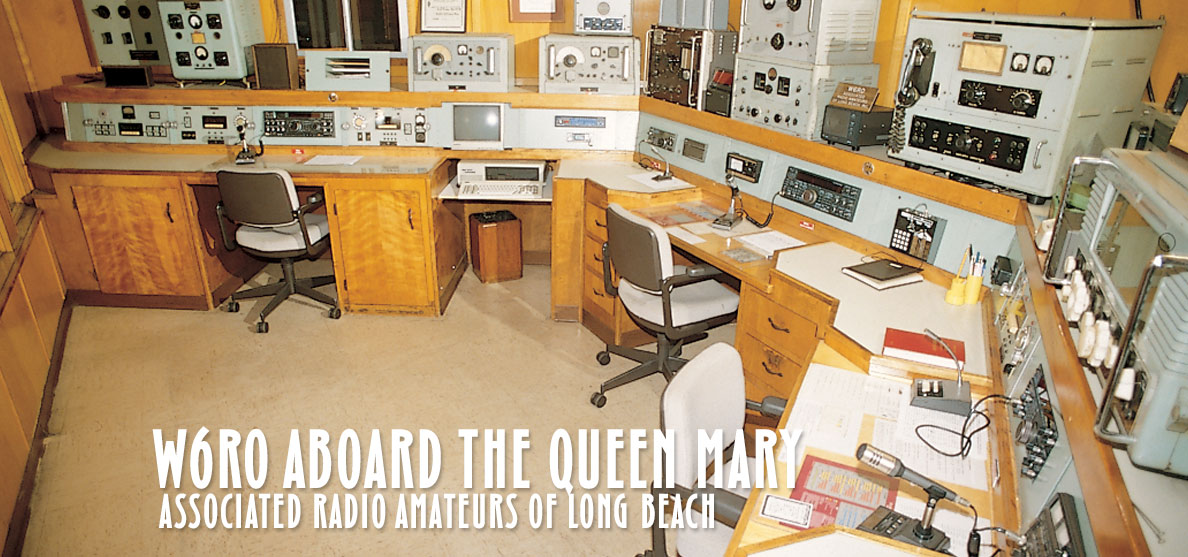A Historic Icon of Communication and Radio Technology Listen to This
The Queen Mary is known not only for its luxurious accommodations and impressive size, but also her rich history in communications and amateur radio capabilities. Visitors can tour the ship's radio room and learn about its fascinating history in communications technology. The Queen Mary's legacy in this field is an important part of its overall historical significance and continues to be celebrated by those interested in both maritime history and amateur radio operations.
Like all other vessels of her era, The Queen Mary used maritime MF and HF radio frequencies to communicate with other ships and with shoreside high seas radio stations. Most of the world’s shipping lines contracted with radio companies to provide equipment and skilled radiomen for their ships, the largest being Marconi’s Wireless Telegraph Company. Cunard Lines selected the much smaller International Marine Radio Company to provide their ships with radio equipment and operators. IMRC designed and custom-built most of the equipment used on Cunard liners, and employed the radiomen who maintained and operated it. Some of that IMRC-built equipment is still on display in the Wireless Room. IMRC radiomen sailed on every voyage of The Queen Mary, using the radio callsign GBTT, providing communications in support of inter-ship safety, navigation, weather, news reports, ship’s business, crew and passenger messages, and even radio-to-landline telephone calling for those who would pay the rather high prices for that service. Except for the ship-to-shore radiotelephone calls, most other traffic was passed using Morse code radiotelegraphy. In this era, radiotelegraphy was more efficient and reliable, being able to get through noise and signal fading much better than the AM and SSB voice modes.
Even into the 1950s and 1960s, when amateur radio became increasingly popular, IMRC radiomen weren’t much interested in tuning-in and operating on the ham radio frequencies. Indeed, after working a watch of four to six hours of pretty much constantly sending and copying Morse code traffic, the radiomen had little desire to do more of the same on the ham bands on their own time.
Amateur radio first came aboard The Queen Mary for her Last Great Cruise in 1967. Upon learning that the City of Long Beach was considering the purchase of The Queen Mary to serve as a larger-than-life icon of its emerging status as an “International City,” Long Beach resident and radio amateur Nate Brightman, K6OSC, fell head-over-heels in love with the idea. He bent every ear and pulled every string he could to convince city leaders to go ahead with the deal. They heard him, and the purchase was made. Then, learning about the emerging plans for a Last Great Cruise to deliver the liner to Long Beach, Brightman hatched a plan to place an amateur radio station aboard the ship to contact and converse with radio amateurs around the world during The Queen Mary’s Last Great Cruise.
Brightman had to overcome many significant impediments to this project. The Cunard Line, US State Department, and the British Government all had to be brought into agreement to permit this event to happen. When all was arranged, Long Beach radio amateur Al Lee, W6KQI, led a team of amateurs as they flew to England, boarded The Queen Mary, installed their radio equipment, and broadcast from The Queen Mary at sea using the British-issued callsign GB5QM during the Last Great Cruise. Every radio amateur around the world who contacted GB5QM was sent a commemorative “QSL” (confirmation of radio contact) certificate. One of these certificates is still on display in the radio display room.
Nate Brightman’s vision for amateur radio aboard The Queen Mary did not end when she reached her final mooring in Long Beach. He was already at work on a plan to establish a permanent amateur radio station aboard the ship. This proved to be his most daunting undertaking ever, requiring 11 years of persistent negotiating to convince City and ship officials to grant his aspiration. Space was approved on the Sports deck in the structure originally housing the ship’s squash court. This was an ideal location as it provided direct access to the roof overhead for antennas and was able to be passed by visiting tourists as they exited the wheelhouse and officer’s quarters exhibits. Construction was funded by the City, and the console was recreated from Brightman’s own photos of the ship’s original Wireless Telecommunications console, formerly located on the Promenade deck portside, photos which he shot during a VIP tour shortly after the ship’s arrival in Long Beach in 1967.
Amateur radio equipment for The Queen Mary’s new Wireless Room was donated by the Swan Radio Company of Oceanside upon Brightman’s request to the company’s founder Herb Johnson. The equipment and antennas were installed, some of the ship’s original radio equipment was added for display, and the new Wireless Room was opened for operation on April 22, 1979. From that date forward, volunteer radio amateurs from the local ham radio club, the Associated Radio Amateurs of Long Beach, as well as others from all over southern California, have staffed the Wireless Room, making radio contact with hams across the US and around the world and demonstrating ham radio to the ship’s tourists as they pass by. Many of them still use Morse code.
Brightman served as manager of the station from 1979 until his retirement in 2013 – nearly 35 years! The station was re-dedicated as “The Nate Brightman Wireless Room” in 2007 in his honor. W6RO enjoys worldwide fame on the ham radio bands. Amateurs who make an on-air contact with the station are sent the very popular W6RO “QSL” card commemorating their exchange with The Queen Mary.
